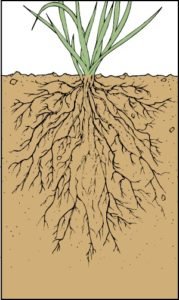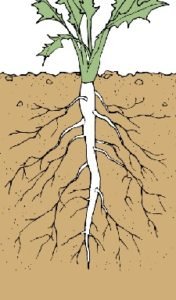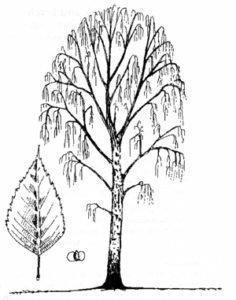Branching Roots

Prop Roots

TAP Root

Aerial roots
 Roots are organs of attachment (anchoring the plant to the ground) and organs of absorption and transport for water and dissolved salts. The tip of the root, called the root cap forces its way into solid earth. For this purpose the root cap is made up of layers of flattened and hardened cells.
Roots are organs of attachment (anchoring the plant to the ground) and organs of absorption and transport for water and dissolved salts. The tip of the root, called the root cap forces its way into solid earth. For this purpose the root cap is made up of layers of flattened and hardened cells.
Behind the root cap is a thick white down consisting of thousands of tiny hairs. This part of the root has the function of absorbing water, with mineral salts dissolved in it, from the soil. Water is absorbed into the roots by a process called osmosis. The liquid inside the root hairs is a rather strong solution of sugars and mineral salts; the water in the soil is a weak solution of mineral salts. The outer skin of the root hairs is a semi permeable membrane, with the special property of enabling weaker solutions to pass through into stronger ones. As long as the solution inside the root hairs is stronger than that outside, they will take in water that is carried up to the aboveground parts of the plant through slender tubes of xylem and phloem.
Roots sometimes give out substances in solution. If the root meets a hard substance such as marble, which is insoluble in water, it gives out carbon dioxide. When mixed with water, this carbon dioxide acts on the calcium carbonate in the marble and turns it into soluble sodium bicarbonate that the root can then absorb.
Root growth
Normally, roots grow downward under the influence of gravity and away from light. This reaction enables a sprouting seed to get a hold in the soil.
There are two basic patterns of root growth:
The taproot system found, for example, in dandelions
The fibrous system found as in grasses. In fibrous systems the primary root is displaced by numerous fine roots from the base of the stem.
The taproot system is an extension of the primary root (radicle) of the young seedling.
All roots that do not grow from the primary root (ex. roots on a rhizome) are called adventitious. Propagation of plants by cuttings relies on the development of adventitious roots on the stem.
Root structure
At the tip of all roots is a mass of cells – the root cap – that protects the growing point during its passage through the soil. The actively dividing cells of the growing point produce the cells of the root cap. As the outer parts of the root cap wear away, fresh cells replace them. The old cap cells may also lubricate the tip, as it grows downward. Cells formed just behind the tip lengthen rapidly and push the tip further into the soil with considerable force.
The growing region is followed by the root hair region. The hairs are outgrowths of the epidermis and are the main organs of absorption. They penetrate the soil and absorb water and occupy only a limited region. Hairs in the growing region would be sheared off as the root pushed downward. Each hair has only a brief existence and as the hairs die off they are replaced with new ones further down.
The root contains the same sort of tissues as the stem but the strengthening tissues of the root are centrally placed, reflecting the pulling strain suffered by the root as opposed to the bending strain imposed on the stem.
Cross sections of the root hair region of a typical root are shown in the illustrations. The inner layer of the wide cortex is called the endodermis. The walls of this layer become thickened with a corky substance. Within the endodermis is the stele whose outer layer is of parenchyma cells and is called the pericycle. The protoxylem is on the outside of the xylem tissue that is star-shaped as a rule. Monocotyledons (grasses) usually have more “arms” than dicotyledons (buttercups). A central pith occurs in some species. Secondary growth usually occurs only in dicotyledons.
Branching in the root
In the stem, buds develop from the outer tissues close to the tip. Root branches develop behind the growing region and are endogenous (they develop internally). Branching develops before secondary thickening begins. Cells of the pericycle opposite the protoxylem groups become active and produce a growing point just like that of the main root. This new tip grows through the cortex just as the main root grows through the soil. When it breaks out of the parent root the vascular connections are complete and the region is behind that of the root hairs.
Between the root and the stem is a region called the hypocotyl. In this region the vascular tissues change from the root arrangement to that of the stem, but they are continuous all the way through.
Uses of Roots
Many plants are economically important root crops. Taproots, such as the beet, carrot, parsnip, radish, turnip, sweet potato, salsify, and cassava are used as food. Many fibrous and taproots are used for flavorings or in making medicines. Goldenseal, jalap, licorice, and mandrake roots are used in flavoring medicines. Common food flavorings are obtained from the roots of such plants as ginger, horseradish, angelica, and sarsaparilla. Some of the roots used in making drugs are colchicum and ipecac. Fibrous root systems are also agriculturally important because they hold topsoil in place and prevent soil erosion
Roots growing aboveground from parts of the plant other than the stem base are called adventitious roots. There are two kinds of adventitious roots: prop roots and aerial roots. Prop roots, and many aerial roots, penetrate the soil. For example, prop roots of corn grow from upper parts of the stem down to the soil, and the aerial roots of poison ivy grow from horizontal branches down to the soil. Some aerial roots do not penetrate the soil, but become attached to other plants or objects instead. Plants with such roots are called epiphytes. Many orchids are epiphytes.
Root modifications
Very often the root is modified for storage. Roots which survive the winter contain food material which will be used by the developing shoots in spring. The climbing roots of ivy are adventitious – arising all the way along the stem – and the roots on strawberry runners. Some tropical orchids that grow on tree-trunks have spongy roots exposed to the air. The roots absorb moisture and may contain chlorophyll too.
Maize plants and many others have stilt roots that develop from nodes on the stem and provide extra support. The banyan tree uses prop roots. Roots develop in the horizontal branches and grow into the soil. They form solid supports for the spreading branches.
Some swamp-growing plants such as mangroves develop breathing-roots. The swampy soil is poor in oxygen and some root branches, which may or may not be adventitious, grow upwards into the air. Oxygen diffuses into these and into the rest of the root system.
The term “bulb” is used by most people to refer to plants with underground fleshy storage structures. Only some of the plants commonly called bulbs actually are bulbs. The definition of a bulb is any plant that stores its complete life cycle in an underground storage structure. The primary function of these underground storage structures is to store nutrient reserves to ensure the plants’ survival. Bulbs or bulb-like plants are usually perennials. They have a period of growth and flowering followed by a period of dormancy. They die back to ground level at the end of each growing season. For spring bulbs, the end of the growing season is in late spring or early summer. Spring bulbs start to grow again in the fall and flower the following growing season.
Bulbs can be broken down into five types of storage structures: true bulbs, corms, tubers, tuberous roots and rhizomes. A sixth category of fleshy roots has been added for the purpose of showing the structure.
True Bulbs
The true bulb has five major parts. It contains the basal plate (bottom of bulb from which roots grow), fleshy scales (primary storage tissue),tunic (skin-like covering that protects the fleshy scales), the shoot(consisting of developing flower and leaf buds), and lateral buds (develop into bulblets or offsets).
True bulbs are divided into tunicate bulbs and imbricate bulbs. A tunicate bulb has a paper-like covering or tunic that protects the scales from drying and from mechanical injury. Examples of tunicate bulbs are: tulips, daffodils, hyacinths, grape hyacinths, and alliums. Many plants such as daffodils form new bulbs around the original bulb. These bulbs, called offsets, develop from buds within the base of the mother bulb and produce new plants. When bulbs become too crowded, the flowers start to diminish in size. It is time to dig up and divide the bulbs.
An example of the imbricate bulb is the lily. The imbricate bulb does not have the tunic (papery covering) to protect the fleshy scales. Imbricate bulbs must be kept constantly moist before planting so they aren’t injured by their scales drying out.
Lilies can be propagated from bulbils that develop in the leaf axils of the plant and from bulblets that develop at the base of fleshy lily scales if maintained in a moist sand medium. It will take more than one year for the bulbils or bulblets to flower.
Corms
A corm is a swollen stem base that is modified into a mass of storage tissue. A corm does not have visible storage rings when cut in half. This distinguishes it from a true bulb. The corm contains a basal plate (bottom of bulb from which roots develop), a thin tunic and a growing point. Examples of plants that develop from corms are gladiolus and crocus. When gladiolus corms are dug in the fall, they should be separated into well-developed corms and stored for replanting. Newly dug corms will have cormels that are pea size around the top of the old corm. The old corm will be directly beneath the newly formed corms. When the corm is cleaned up and the old stem removed, the growing point of the corm will be evident. The cormels can be saved and replanted in the back of the garden. Examples of plants that develop from corms are gladiolas and crocus.
Tubers
A tuber differs from the true bulb and the corm by not having a basal plant from which roots develop and not having a protective tunic covering. The caladium tuber has buds scattered over the tuber surface from which shoots and roots develop. Examples of plants that develop from tubers include caladiums, oxalis and anemones, and the common vegetable, the potato.
Tuberous Roots
The tuberous root differs from other root structures by the nutrient reserves being stored in an actual root instead of an enlarged stem. The dahlia reproduces from buds at the top end of the root or base of the stem. The tuberous root of a dahlia should not be divided before placing in storage in the fall but should be divided at planting time. The root should be divided into sections with an eye-bearing portion of the stem left with each section of the root. The tuberous-rooted begonia reproduces from buds on top of the round, flat tuber.
Rhizomes
Rhizomes differ from other storage structures by growing horizontally just under the surface of the soil. On some plants, this type of rooting structure can be very invasive. The lily-of-the-valley rhizome spreads horizontally underground and produces pips that develop into new plants. This plant is increased in the landscape by digging in the fall and removing pips with developed roots for replanting.
Fleshy Roots
Plants that have fleshy roots store nutrient reserves in the fleshy roots. Peonies and daylilies can be propagated by dividing them. The root clumps of peonies should be divided in the fall leaving at least three crown buds with each clump. The daylily can be divided in the fall or spring into plantlets with a single fan of leaves. The daylily has a fleshy root system with some varieties having what might be considered a rhizome type root system.
The birch tree produces a “plate” root that only takes hold of the soil superficially. It will grow in poor soils but depletes them even further.
The oak tap root is said to go down as deep as its crown extends up into the sky. In spite of this, it does not exhaust the soil but rather tends to improve it.
Roots of the Oak Tree

Roots of the Birch


